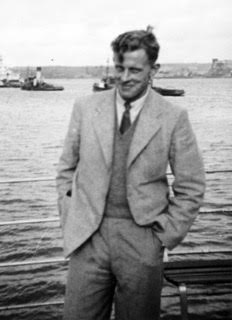Budleigh's Murray Levick: a Hero of Gallipoli
These six men, including Murray Levick (second from right), the northern party of Captain Scott's last expedition, stand outside the entrance to the snow hole in which they have just spent the 1911-1912 Antarctic Winter in darkness.
Image credit: Scott Polar Research Institute
Murray Levick, who lived on the outskirts of Budleigh Salterton in his retirement, is well known as an Antarctic explorer and authority of penguins. But he also had a distinguished service career in WW1.
Born in Newcastle upon Tyne in 1876, Levick joined the Royal Navy in 1910 after a short medical career. It was as a member of the six-strong Northern Party that he took part in Captain Scott's ill-fated 1910-13 Terra Nova Expedition for which he had been recruited as medical officer and zoologist. The group spent the summer of 1911–1912 at Cape Adare in the midst of an Adélie Penguin rookery. Levick's observations of the birds were later published in his 1914 book Antarctic Penguins.
Prevented by pack ice from embarking on the SS Terra Nova in February 1912, Levick and five fellow-explorers survived the seven-month ordeal of a pitch-dark Antarctic winter huddled in a cramped ice cave. They survived on a diet of meat and blubber and a unique brand of resilience and comradeship. Levick's record of the conditions that the group endured tells a tale of heroism and courage in appalling circumstances.
The sun finally appeared with the end of the Austral winter. "It was like living again after being dead for six months," wrote Levick. On 30 September 1912 the group was finally able to walk and ski the 230 miles to Cape Evans and the Terra Nova, only to learn the tragic news of the death of all five members of Scott’s Polar Party.
HMS Bacchante This is photograph Q 20987 from the collections of the Imperial War Museums (collection no. 2107-01)
Having survived the icy wastes of Antarctica, Murray Levick found himself a few years later as a naval surgeon on board the cruiser HMS Bacchante in the thick of the action at Gallipoli, enduring the blistering heat of the Eastern Mediterranean.
The landing of Allied troops at Anzac Cove (Gaba Tepe) on 25 April 1915 resulted in intense fire from Turkish artillery and Bacchante was ordered to approach close to shore and to fire directly on the gun emplacements in an attempt to silence them. The exact number of the day's casualties is not known but it is estimated that over 2,000 Allied troops were killed or wounded, together with at least a similar number of Turkish casualties.
Arrangements to deal with the Allied wounded
proved to be unsatisfactory as the campaign progressed. A grim picture was
painted by the British war correspondent Henry Woodd Nevinson.
HM Transport ship Saturnia, used to carry casualties from Gallipoli, was reportedly in poor condition
Image credit: http://21stbattalion.ca
'In spite of the lamentable experiences at the
first landings, the arrangements for the removal of the wounded from the
Peninsula were still inadequate,' he wrote in his 1918 book 'The Dardanelles
Campaign'.
'The four original hospital ships were present — two military and two lent by the navy — each adapted to receive about 500 men. The remainder of the wounded had to be put on transports not specially prepared, and not protected by The Hague Convention from attack. Before new hospital ships arrived (about fifty at the end), this lack of accommodation caused many deaths and much suffering after a battle on the Peninsula. A particular instance, much spoken of and strongly condemned at the time, was the case of the transport Saturnia, which appeared at Mudros after the attack of June 28 with about 700 on board, crowded haphazard into any corner, in much confusion, and so neglected that their wounds were in many cases putrefying and full of maggots. The transport, having been used for horses and mules, was also in a filthy and stinking condition.'
Murray Levick was personally singled out by Nevinson for the care that he gave to the wounded.
'Supported by Surgeon Lorrimer of the same ship, and a Catholic priest, he remained on board four days and nights, constantly operating. But, for want of adequate assistance, and owing to the lack of bandages, dressings, and instruments, comparatively little could be effected, and many died who might have recovered with proper care.
Such incidents were but further evidences of the general confusion due to an unexpected war, and of the secondary position assigned to the Dardanelles in the Cabinet's strategy.'
‘The Great War at Fairlynch’ was the title of the 2015 exhibition at Budleigh Salterton’s very special museum! Reviews included: "Wonderful display on WW1, informative, bright and relevant. Well done!!"
https://budleighpastandpresent.blogspot.com/2011/02/local-heros-fairlynch-exhibition-will.html
Murray Levick: Champion of the Disabled
https://budleighpastandpresent.blogspot.com/2011/02/hero-of-budleighs-heritage.html
Murray Levick: The man who helped thousands to fill the gap
https://budleighpastandpresent.blogspot.com/2011/04/man-who-helped-thousands-to-fill-gap.html
You can access other posts on this blog by going to the Blog Archive (under the ‘About Me’ section), and clicking on the appropriate heading.







Comments
Post a Comment